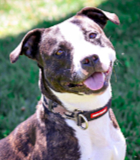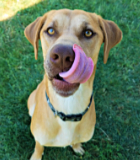Teaching Your Dog to Settle
- This topic has 0 replies, 1 voice, and was last updated 14 years, 12 months ago by
Mackenzie’s Admin.
-
AuthorPosts
-
June 11, 2010 at 6:45 pm #529
Mackenzie’s Admin
MemberTeaching Your Dog to Settle
Teaching your dog to go to a designated spot, like a bed or a mat, and stay there can prove useful in a variety of situations—like when you’re eating dinner, watching a movie with friends, greeting guests at the front door or visiting friends and family with your dog. Once your dog has mastered this skill, you can use it almost anywhere, whenever you need her to settle down for a while.
Teach Your Dog to Go to a Spot
First, you’ll need to teach your dog that her mat or bed is a great place to be. Cut some treats into bite-sized pieces before you begin training. Use something really exciting, like soft dog treats, chicken or cheese. The more your dog loves the training treats, the harder she’ll work to earn them.Step One: Follow the Treat
Call your dog over to the bed or mat you’d like to use. Standing just a foot or two in front of the mat, say the cue, “Go to your spot.”
Hold a treat in front of your dog’s nose so she sees that you have something delicious, and then toss the treat onto the mat.
Your dog will step onto the mat to eat her treat.
Clap your hands and walk a few steps away to encourage your dog to move off of the mat.
Repeat this sequence, tossing the treat to guide your dog onto the mat from various angles. Eventually, your dog will start to seem reluctant to move way from her mat. (Why would she want to be anywhere else? That’s where she gets delicious treats!) At this point, when your dog starts to “stick” to the mat, you can move on to Step Two. Some dogs will need several training sessions to get to this point; others will be ready after only 15 to 20 repetitions.Step Two: Follow the Hand
Now, instead of tossing a treat to guide your dog onto the mat, you’ll introduce a hand signal. Practice Step One a few times to warm up. Then follow these steps:Put a treat in one hand and hide it behind your back.
Standing a couple of feet away from the mat, say “Go to your spot.”
Using your empty hand, point to the mat. Your movement should look a lot like the one you made in Step One when tossing a treat. In response to your pretend toss, your dog should turn her head toward the mat. When she does, take the hidden treat from behind your back and toss it onto the mat. (This will convince your dog that she’ll still get a treat when she goes to the mat, even if she doesn’t see you toss it when you gave your hand signal.)
Encourage your dog to move off of the mat so you can start over again. Repeat the sequence above 15 to 20 times.
Eventually, your dog will go all the way to her mat when you give the hand signal. As soon as all four of her paws are on the mat, say “Yes!” Then, instead of tossing the treat, walk over to the mat and feed your dog the treat from your hand.
Repeat Step Two for a few days, using your new hand signal to guide your dog onto the mat from various angles. When your dog readily moves onto the mat as soon as you give the hand signal, you can move on to the next step.Step Three: Go to the Mat from a Distance
If you’d like to teach your dog to go to her mat on her own from a distance, follow the guidelines below. However, you can skip this step if you don’t mind walking with your dog to her mat when you’d like her to settle on it.Continue to practice Step Two for a few more days, gradually increasing the distance your dog must travel to get to her mat. At first, stand just two feet away from the mat.
Say “Go to your spot.”
Point toward the mat as you did in Step Two.
Wait silently for your dog to move onto her mat. When she does, say “Yes!” and give her a treat.
Practice this sequence until your dog quickly goes to her mat as soon as you say the cue and point. Then try standing three feet away from the mat. When she’s good at that, try standing four feet away. Then try five, then six, etc. When you can stand 10 to 12 feet away and send your dog to the mat, proceed to the next stage—teaching her to stay there.Teach Your Dog to Settle and Stay in Her Spot
Now that your dog knows how to go to her mat, you can teach her to stay there. Before you start this stage of training, your dog will need to learn how to lie down when you ask her to and stay. (For help teaching your dog these basics, please see our articles on Teaching Your Dog to Lie Down and Teaching Your Dog to Stay.)When you’re ready to train, take your dog’s mat and put it next to a comfortable chair or sofa where you can relax and read or watch TV while your dog learns to stay in her spot.
Step One: Stay on the Mat
Say “Go to your spot,” and point to the mat.
When your dog moves onto the mat, praise her enthusiastically and ask her to lie down. Then say “Stay.”
Count to 10 in your head.
Then say “Yes!” and give your dog a treat.
After your dog has finished her reward, release her with “Okay” to let her know her job is done. Encourage her to move off of the mat by clapping or taking a few steps away. Then start again from the beginning.Repeat the sequence above for a number of days, gradually increasing the time that you ask your dog to remain settled on her mat. (If your dog already knows the Stay command well, you’ll progress quickly.)
As you increase the time, randomly throw in some easy short repetitions. Start with 10 seconds, and then increase to 15. Try 20 seconds, and then go back to 10. Increase to 25 seconds, then 30, then 40, and then an easy 10 again. While your dog’s staying on her mat, reward her randomly. At first, be generous and reward every 10 seconds on average. Once she’s getting the hang of it, you can gradually reduce the number of treats you give while your dog stays.
If your dog gets up before you release her, gently take her by the collar and lead her back to her mat. Ask her to lie down and stay, but don’t give her a treat. (If you do, she might learn that the way to get another treat is to break her stay!) Have your dog stay on the mat for at least 15 seconds. Then reward and release her. If she’s getting up a lot, you’re progressing too quickly. Your dog needs some shorter, easier repetitions for a while to really understand what you want her to do.
When you build up to about three minutes on the mat, you can start giving your dog something to keep her busy and happy while she stays in her spot for longer periods of time. After you send your dog to her mat and ask her to stay, hand her a tasty new rawhide, pig ear or bully stick—or stuff a KONG® toy with something delicious and let her work on that. (Please see our article on How to Stuff a KONG Toy to learn about using food-puzzle toys.) While your dog enjoys her goodie, you can sit down right next to her and read or watch TV. When her time on the mat is up, release her with “Okay,” and then take away the chew or KONG. (She only gets her special treat when she’s in her spot.)
When you’ve worked up to 5 to 10 minutes of mat time, you can proceed to Step Two.
Step Two: Add Distance
After your dog learns to settle down in her spot for a while, you can teach her to stay in place while you move away from her.Say “Go to your spot,” and point to the mat.
When your dog moves onto the mat, praise her enthusiastically and ask her to lie down. Then say “Stay.”
Move a few steps away from the mat.
If your dog stays, say “Yes!” Then quickly return to the mat and give her a treat.
After your dog has finished eating her treat, say “Okay” to release her.
Encourage your dog to come off of the mat by clapping or moving a few steps away. Then you can start again from the beginning.Repeat the sequence above for a number of days, gradually increasing the distance that you move away from your dog while she stays on her mat. Start with two steps, and then increase to three or four. Then try five or six. Then throw in an easy repetition and only move one step away. Then go back to five steps. Increase to seven steps, then eight or nine, then an easy five steps again. Because you’re making the exercise harder by adding distance, only require your dog to stay for short periods of time—30 seconds to a minute at most.
When you’re able to walk about 15 steps away from your dog while she stays on her mat, you can move on to Step Three.
Step 3: Put Time and Distance Together
Now that you’ve worked on both increasing the time your dog stays on her mat and the distance you move away, you can try putting those two things together.Repeat Step One: Stay on the Mat, but this time, try moving away from your dog when you ask her to stay on her spot for longer periods of time. When you’re ready to train, put your dog’s mat six to eight feet away from your comfortable chair or the sofa. After you say “Go to your mat” and ask your dog to lie down and stay, hand her a stuffed KONG or something tasty to chew. Then move to your spot and relax for five minutes or so. When the time’s up, release your dog with “Okay,” and then take away the chew or KONG.
Practice this step for a few days, slowly increasing both the distance between your dog’s spot and where you sit and the time that your dog stays on the mat. Remember to throw in some easy, short repetitions so that your dog doesn’t get bored or frustrated.
Step 4: Add Distractions
So far, you’ve been practicing in calm, quiet places with little to no distraction. Now you can start to add some distraction to the scenario. Practice in a variety of locations and situations. When your dog becomes a pro at staying on her mat when there are distractions around, you’ll be able to start using this skill in real life.Set your dog up to succeed by increasing distraction slowly. First, practice in various quiet places, like all the rooms in your house. Then try slightly more distracting places and situations. You can practice in your house when family members are moving around, when you’re cooking in the kitchen and when you’re eating dinner at the table. Try practicing at friends’ houses, too. When your dog can reliably stay in her designated spot in these distracting places, add even more distractions. Practice when guests ring the doorbell. You can reward your dog by releasing her to greet the visitors. Try practicing while someone bounces a ball or squeaks your dog’s favorite toy nearby. If she stays, you can release her and reward her with a quick game.
If your dog can’t stay on her mat when you move to a new location to train, you may have progressed too quickly. Try going back to a slightly less distracting location to practice for a while or asking her to stay for a shorter period of time. After a few successful sessions, you can try making things a little harder again.
Training Tips
Set your dog up for success by training when she’s exercised and calm. It’s also a good idea to hold training sessions when your dog’s hungry so that she’s extra-motivated to earn her treats, chew or KONG.
When your dog is in her spot, resist the urge to repeat “Stay.” It’s fine to say it one time to remind your dog that you’d like her to settle down once she gets to the mat—but once should be enough. Chanting “Stay…stay…stay…” the whole time your dog is on her mat is a lot more work for you!Remember to use the release word “Okay” to tell your dog when she can get up. You don’t want her to think she can release herself.
If your dog stands up, turns around, sits or flops over on her side, that’s fine. She may need to readjust to stay comfortable on her mat. But if she gets up and steps off of her mat, immediately say “Oops!” and rush over to lead her back to her spot. When she’s standing on her mat again, ask her to lie down and remind her to stay. After 30 seconds or so, give her a treat to let her know that you love it when she stays put in her spot.
During the training process, you can use a leash or tether attached to a heavy piece of furniture to remind your dog to stay in her spot. After securing the tether to the furniture, say “Go to your spot.” Then ask your dog to lie down and stay. When she’s in position, attach the tether to her collar. After your dog’s time on the mat is up, unhook the tether and say “Okay” to release her. -
AuthorPosts
- You must be logged in to reply to this topic.












































